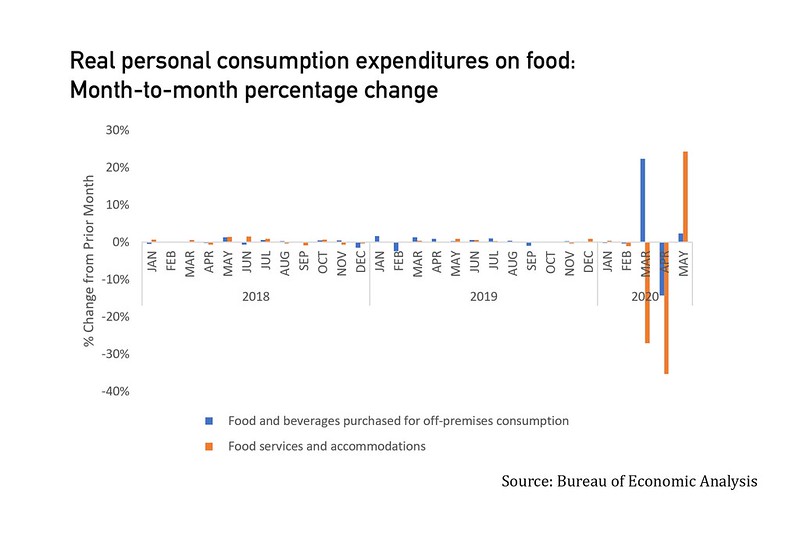June 30, 2020
Pent-up demand breaks loose as consumer spending rose in May; still below pre-pandemic levels
By Mary Hightower
U of A System Division of Agriculture
Fast Facts:
- Consumer spending rises 8.2 percent in May
- Clothing, recreation, food spending all up
- May BEA report reflects reopening
(392 words)
(Download this story in MS Word format here.)
FAYETTEVILLE, Ark. — Consumer spending rises as states reopen, but levels remain below pre-pandemic levels, according to an economic analysis released Monday by the University of Arkansas System Division of Agriculture.
The analysis is by John Anderson, head of the agricultural economics and agribusiness department of the University of Arkansas System Division of Agriculture and the Dale Bumpers College of Agricultural Food and Life Sciences. Anderson looked at the May report from the Bureau of Economic Analysis, or BEA, which was released Friday.
Monday’s report is part of the department’s weekly analyses of the impact of COVID-19 on the economy.
“Personal consumption expenditures rose substantially — 8.2 percent — in May compared to the prior month as states begin to lift stay-at-home orders,” he said. “Expenditures were up across all major categories of spending: Durable goods, non-durable goods and services.”
The durable goods category includes items such as cars, appliances and furniture. Non-durable goods include food and clothing.
Pent-up demand
“It is clear that quite a bit of pent-up demand developed in several product categories
over the course of the shutdown,” Anderson said. “For example, real personal consumption
expenditures on clothing and footwear increased by 43 percent in May compared to April.
Spending on recreation increased 15 percent.”
He noted that spending on food also increased in May over April.
“Food-at-home spending was still considerably lower than during the March stockpiling phase of the pandemic, but it remained high relative to normal,” Anderson said. “Perhaps because food was one of the few things that those under stay-at-home orders could go out and routinely purchase.”
“Food service spending in May increased by well over 20 percent from April as the restaurant trade began to resume in much of the country,” he said.
Personal income
The BEA report indicated that personal income was down 4.2 percent in May versus April.
“However, that figure is not as negative as it might seem,” Anderson said. “In April, personal income had been buoyed by the unprecedented flow of emergency relief funds, primarily in the form of direct payments to all taxpayers and enhanced benefits to unemployed workers.
“Personal income declined primarily due to a slowdown in government transfers,” he said. “At roughly $5.2 billion, government social benefits to individuals seems historically large, but were a little more than $1 billion lower than in the prior month.”
To learn about extension and research programs in Arkansas, visit uada.edu, Follow us on Twitter at @AgInArk, @uaex_edu or @ArkAgResearch.
About the Division of Agriculture
The University of Arkansas System Division of Agriculture’s mission is to strengthen agriculture, communities, and families by connecting trusted research to the adoption of best practices. Through the Agricultural Experiment Station and the Cooperative Extension Service, the Division of Agriculture conducts research and extension work within the nation’s historic land grant education system.
The Division of Agriculture is one of 20 entities within the University of Arkansas System. It has offices in all 75 counties in Arkansas and faculty on five system campuses.
Pursuant to 7 CFR § 15.3, the University of Arkansas System Division of Agriculture offers all its Extension and Research programs and services (including employment) without regard to race, color, sex, national origin, religion, age, disability, marital or veteran status, genetic information, sexual preference, pregnancy or any other legally protected status, and is an equal opportunity institution.
# # #
Media Contact: Mary Hightower
Chief Communications Officer
University of Arkansas System Division of Agriculture
mhightower@uada.edu
501-671-2006
